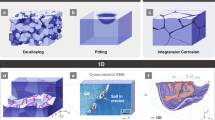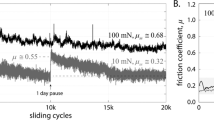Abstract
THE electrochemical-mechanical theory now favoured states that the dislocation substructure is the controlling factor in the process of stress-corrosion cracking of austenitic stainless alloys1–4. If the dislocations become piled up on slip planes due to a low stacking fault energy, a susceptible alloy results. On the other hand, if a cellular arrangement is obtained as a result of a high stacking fault energy, the alloy is not susceptible to failure. The emergence of the dislocation pile-ups at the surface produces the chemically reactive sites for crack initiation. To explain the apparently anomalous stress-corrosion resistance of ‘Incoloy 800’ (high stacking fault energy and a planar dislocation arrangement) and nichrome (planar arrangement) the concept of short-range order was introduced2,3. It was postulated that in the higher nickel alloys short-range order is present which on deformation leads to a planar structure in spite of a high stacking fault energy. The disorder on the slip planes created by the passage of dislocations results in chemically reactive sites on the surface. Furthermore, it was postulated that if re-ordering can occur at a rapid enough rate the chemically reactive sites are destroyed and the resistance to stress-corrosion failure is high2,4.
This is a preview of subscription content, access via your institution
Access options
Subscribe to this journal
Receive 51 print issues and online access
$199.00 per year
only $3.90 per issue
Buy this article
- Purchase on Springer Link
- Instant access to full article PDF
Prices may be subject to local taxes which are calculated during checkout
Similar content being viewed by others
References
Stickler, R., and Barnartt, S., J. Electrochem. Soc., 109, 343 (1962).
Swann, P. R., Corrosion, 19, 102 (1963).
Douglass, D. L., Thomas, G., and Roser, W. R., Corrosion, 20, 15 (1964).
Thomas, K. C., Stickler, R., and Allio, R. J., Corrosion Science, 5, No. 1, 71 (1965).
Bell, W., Roser, W. R., and Thomas, G., Acta Met., 7, No. 11, 1247 (1964).
Thomas, K. C., Ferrari, H. M., and Allio, R. J., Corrosion, 20, No. 3, 89 (1964).
Bergen, C. R., Corrosion, 20, 269 (1964).
Author information
Authors and Affiliations
Rights and permissions
About this article
Cite this article
THOMAS, K., ALLIO, R. An Integrated Theory of Stress Corrosion. Nature 206, 82–83 (1965). https://doi.org/10.1038/206082b0
Issue Date:
DOI: https://doi.org/10.1038/206082b0
This article is cited by
-
Failure Analysis of Process Equipment Used in the Production of Polyvinyl Chloride
Metallography, Microstructure, and Analysis (2014)
Comments
By submitting a comment you agree to abide by our Terms and Community Guidelines. If you find something abusive or that does not comply with our terms or guidelines please flag it as inappropriate.



